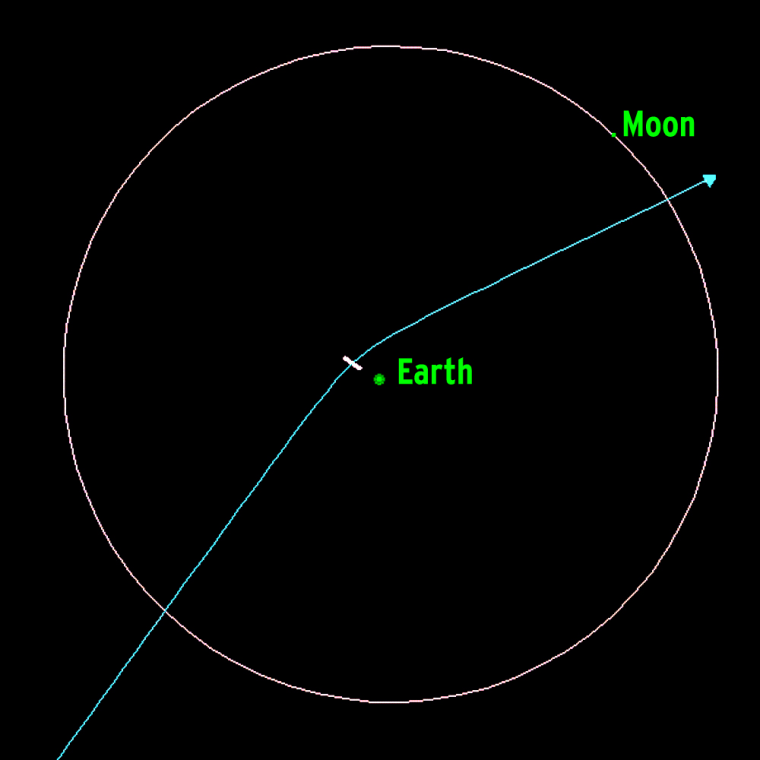An asteroid expected to fly past Earth in 2029 will be visible to the naked eye, scientists projected Thursday.
It's a once-in-a-millennium event. And you may want to buy plane tickets now, as the flyby will be visible only from Europe, Africa and western Asia.
There has been no event like this in modern history. Some people have seen dramatic fireballs created by small space rocks blazing through Earth's atmosphere. And two house-sized asteroids have made closer passes. But they were not visible without telescopes.
The 2029 event will be the closest brush by a good-sized asteroid known to occur. The rock will pass Earth inside the orbits of some satellites. No other asteroid has ever been clearly visible to the unaided eye.
The asteroid is roughly estimated to be a little more than 1,000 feet (320 meters) wide.
It won't hit
The rock, catalogued as 2004 MN4, was discovered last June. It was seen again in December, and for a time scientists said it had the highest odds of hitting Earth ever given to a space rock. Subsequent observations refined the future path and eliminated those odds for the 2029 flyby. It won't hit the moon, either.
This week, NASA scientists used new observations from the Arecibo Observatory to further pin down the track of 2004 MN4.
On April 13, 2029, it will be about 22,600 miles (36,350 kilometers) from Earth's center. That is just below the altitude of geosynchronous satellites, which hover in fixed perches above the planet to communicate with and collect data on half the globe at all times.
Of the 10 known closest asteroid flybys, 2004 MN4 is by far the largest object, said Steve Chesley of NASA's Jet Propulsion Laboratory. Only two have come closer, and they were only tens of yards (meters) wide.
"All of the others in the top ten were discovered during the close approach, whereas for 2004 MN4 the close approach is predicted well in advance," Chesley said in a telephone interview.
Last fall, an even larger asteroid made a notable flyby. That rock, called Toutatis, is about 2.9 miles long and 1.5 miles wide (4.6 by 2.4 kilometers). Its closest approach, widely photographed, was about four times the distance to the moon. It was not visible to the naked eye.
What to expect
The asteroid 2004 MN4 is expected to shine like a fast-moving star at magnitude 3.3, Chesley said. That would be easily visible under dark skies without the help of binoculars or telescopes.
On this astronomers' magnitude scale, smaller numbers represent brighter objects. The brightest stars and planets have negative magnitudes. The dimmest stars visible under perfect sky conditions away from city lights are about magnitude 6.5. Urban residents may need to get out of town to see the rare event.
Chesley said the exact proximity of the object could cause its brightness to vary, but probably only by a few tenths of a magnitude.
The asteroid will pass through the constellation of Cancer. Observers with clear skies in Europe, Africa and parts of Asia will be able to see a star-like point of light.
"Whether you could see it from the center of London is another matter," said Alan Harris of the Space Science Institute.
Harris notes that asteroid Vesta — 334 miles (538 kilometers) in diameter — periodically gets as bright as magnitude 5.3, which is visible to the naked eye under very dark sky conditions. "Curiously, Vesta attains this brightness at its opposition in July 2029, only a few months after the April 2029 apparition of MN4," Harris told Space.com.
With small telescopes and high-tech tracking software, the asteroid's shape could be evident.
"It will be potentially resolvable with small telescopes, but they'll have to be able to track pretty fast," Chesley said.
The rock will cover about 42 degrees of sky per hour, slower than a satellite but noticeably quick in the small field of view of a telescope.
Rare event
On average, one would expect a similarly close Earth approach by an asteroid of this size only every 1,300 years or so, Chesley and his colleagues have determined.
2004 MN4 circles the sun, but unlike most asteroids that reside in a belt between Mars and Jupiter, the 323-day orbit of 2004 MN4 lies mostly within the orbit of Earth.
The 2029 flyby will bend the rock's path and change the circumstances of later close passes to Earth. "However, our current risk analysis for 2004 MN4 indicates that no subsequent Earth encounters in the 21st century are of concern," according to a statement issued by Chesley and his JPL colleagues Paul Chodas, Jon Giorgini and Don Yeomans.
Additional observations in coming months and years could help eliminate the small chances of impacts in years after 2029.
Were an asteroid the size of 2004 MN4 to hit Earth, it would cause local devastation and regional damage. It would not be expected to cause any sort of global disruption, experts say.
